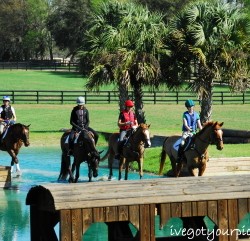I had the privilege of being a demo rider for the Ocala ICP Symposium earlier this week. I was very excited to get a spot riding in the cross country portion with David O’Connor, our new team coach. The only bad thing about riding in it was not being able to watch the group before me, and I could not hear all of what DOC said to the audience. The wind was blowing, making it difficult for the riders to hear what he was saying to us, much less to the audience. (even with a sound system). However, I will share the knowledge that I did absorb!
Our first assignment was to pick up a forward canter and show off our galloping positions. I had always been told to cruise in a more upright position and go to sitting before the fence. David immediately brought me over and placed my foot more in front of me, pushing my butt back and up and my face down more toward Bug’s neck. It felt pretty awkward at first, but once I got cantering, it was actually quite easy. He told me that around a 10 minute course, my horse and I would be exhausted from being in the first position.
We moved on to some smaller fly fences. He told us that when coming to a fly fence, the speed doesn’t need to be changed, just the balance. I am definitely bad about slowing my horse up too much for bigger gallop fences. We were also to be VERY focused on keeping our horses straight on take off and landing. We were to pick a circle on the ground on the landing side and put our horses’ feet in it. He also wanted us to stay very still with our upper bodies over the fence.
Bug has a right drift, especially over bigger fences, and when we moved on to the big table, the drift started to rear its ugly head. David told the crowd that he wants to see a reaction from the rider when things like this happen, even if it doesn’t fix it. He kept after me until I got it right. My Bromont debacle was definitely my fault, and it came from a lack of keeping him straight. Straightness is key. The more you go up the levels, the more you find the holes in the straightness.
From there, we moved on to two mounds, the second had a log on top of it, and a corner about 4 strides away from the base. We practiced going over the mounds at a trot and canter. David was interested to see how the mounds effected our position and how the horses reacted to them. He wanted us to stay very secure and allow the horse’s head and neck down so they could step down the mound nicely, rather than launching off of it inverted. Bug is quite good with using his head and neck, so I could just sit quietly and allow him to do his thing.
Next, we jumped the corner by itself. David was adamant that with schooling, the “out” should always be jumped first, so the horses know what is coming. It starts them looking for the next thing. Finally, we put together the mounds by themselves to the corner, then the mound to the log on the mound to the corner. The exercise rode quite well and was a good test of our straightness and footwork. Footwork is the key to making a good cross country horse.
The last exercise was the most involved. We went over to the bank complex and started slowly working up to the final footwork drill. He had us going up and down the bank, jumping a triple brush, then down the bank to the triple brush, then across a one stride bank. After we did all of that, he started to set up the true exercise which was a vertical, 4 bending strides to an up bank, bounce over a rail, bounce down, 3 strides to a vertical at an angle. It was quite a good exercise to get the horse moving his feet. It was our job as the rider (throughout the whole session) to ride the horses forward to the distances by keeping the footwork going and not trying to find the distance with our hand. We also needed to allow the horse to use its head and neck while we stayed strong in our positions.
As far as the coaching aspect, David told the audience that it is the coach’s job to make the rider more aware of things happening. If you tell the rider something is happening, by the time they change it, it’s over. However, if you keep reminding them to be aware, it will become second nature to feel it and correct it themselves.
It was a really great experience, and I am quite pleased that I got to participate. I thought it was a great school before Bug and I move back up to Advanced this weekend at Pine Top! Many thanks to Longwood Farm and the organizers of the ICP Symposium, and thanks as well to photographer Shelly Simpson and Ivegotyourpicture.com!
(click below to view more photos)
- David fixing my galloping position
- Laura Borson and Shooby Doo
- Working on the right drift
- I am not sure what I’m doing with my face here, but Bug is totally absorbing everything DOC says.
- Ashley Leith and Tactical Maneuver
- Melissa Miller and High Finance
- DOC teaching away. All photos used by ivegotyourpictures.com and used with permission











































































